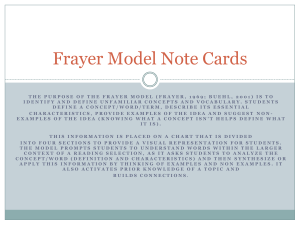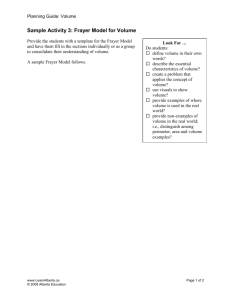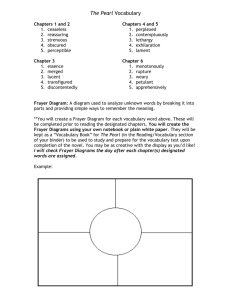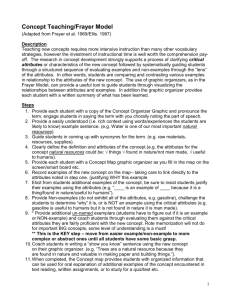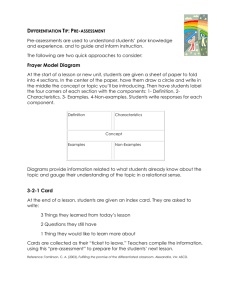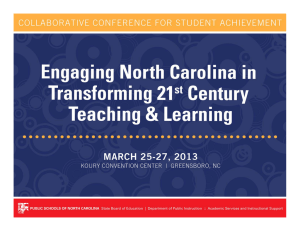R Extending Vocabulary – The Frayer Model Getting Ready to Read:
advertisement
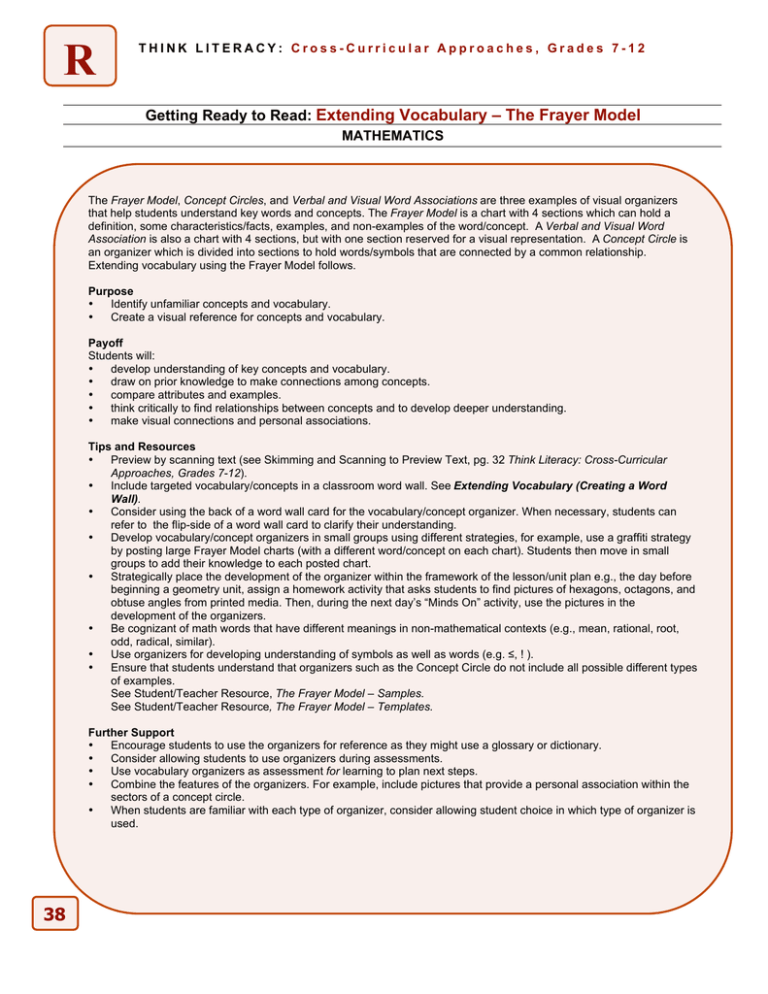
R THINK LITERACY: Cross-Curricular Approaches, Grades 7-12 Getting Ready to Read: Extending Vocabulary – The Frayer Model MATHEMATICS The Frayer Model, Concept Circles, and Verbal and Visual Word Associations are three examples of visual organizers that help students understand key words and concepts. The Frayer Model is a chart with 4 sections which can hold a definition, some characteristics/facts, examples, and non-examples of the word/concept. A Verbal and Visual Word Association is also a chart with 4 sections, but with one section reserved for a visual representation. A Concept Circle is an organizer which is divided into sections to hold words/symbols that are connected by a common relationship. Extending vocabulary using the Frayer Model follows. Purpose • Identify unfamiliar concepts and vocabulary. • Create a visual reference for concepts and vocabulary. Payoff Students will: • develop understanding of key concepts and vocabulary. • draw on prior knowledge to make connections among concepts. • compare attributes and examples. • think critically to find relationships between concepts and to develop deeper understanding. • make visual connections and personal associations. Tips and Resources • Preview by scanning text (see Skimming and Scanning to Preview Text, pg. 32 Think Literacy: Cross-Curricular Approaches, Grades 7-12). • Include targeted vocabulary/concepts in a classroom word wall. See Extending Vocabulary (Creating a Word Wall). • Consider using the back of a word wall card for the vocabulary/concept organizer. When necessary, students can refer to the flip-side of a word wall card to clarify their understanding. • Develop vocabulary/concept organizers in small groups using different strategies, for example, use a graffiti strategy by posting large Frayer Model charts (with a different word/concept on each chart). Students then move in small groups to add their knowledge to each posted chart. • Strategically place the development of the organizer within the framework of the lesson/unit plan e.g., the day before beginning a geometry unit, assign a homework activity that asks students to find pictures of hexagons, octagons, and obtuse angles from printed media. Then, during the next day’s “Minds On” activity, use the pictures in the development of the organizers. • Be cognizant of math words that have different meanings in non-mathematical contexts (e.g., mean, rational, root, odd, radical, similar). • Use organizers for developing understanding of symbols as well as words (e.g. ≤, !). • Ensure that students understand that organizers such as the Concept Circle do not include all possible different types of examples. See Student/Teacher Resource, The Frayer Model – Samples. See Student/Teacher Resource, The Frayer Model – Templates. Further Support • Encourage students to use the organizers for reference as they might use a glossary or dictionary. • Consider allowing students to use organizers during assessments. • Use vocabulary organizers as assessment for learning to plan next steps. • Combine the features of the organizers. For example, include pictures that provide a personal association within the sectors of a concept circle. • When students are familiar with each type of organizer, consider allowing student choice in which type of organizer is used. 38 THINK LITERACY: Cross-Curricular Approaches, Grades 7-12 R Getting Ready to Read: Extending Vocabulary – The Frayer Model MATHEMATICS What teachers do What students do Before • • • • • • • Preview an activity or unit of study for key vocabulary and concepts. Modify the preview list using input from student preview lists. Use a graphic organizer to identify relationships among the words found during the preview and to show connections to students’ prior knowledge from previous units, grades and/or student experiences. Select concepts that have potentially confusing connections or concepts that have several different characteristics. Determine which of the words are critical in developing deeper understanding of the mathematics in the activity or unit. Share a completed Frayer Model for a familiar nonmathematical concept but remove the name of the concept from the model. (See Student/Teacher Resource, The Frayer Model – Samples.) Create large Frayer Models on chart paper. • Preview an activity or unit of study to create a list of unfamiliar vocabulary and concepts. • • Determine the concept name. Ask questions to clarify understanding of the attributes of a Frayer Model. • Contribute to brainstorming. • List essential characteristics that apply to all examples. List non-essential characteristics that apply to subsets of the term/concept Suggest additional words and phrases and non-examples that refine understanding of the term. Ask questions to clarify understanding Actively listen and reflect on learning. During • • • • • • Brainstorm as a whole class to create a list of words/phrases that connect to the concept. Form small groups and distribute one chart paper Frayer Model to each group. Direct students to place words and phrases from the brainstormed list into appropriate sections of the Frayer Model i.e. essential characteristics, nonessential characteristics, examples. Direct students to add more words/phrases as well as non-examples. Circulate and pose questions to refine understanding of the term. Ask a reporter from each group to present the group’s Frayer Model. Post the models around the room. • • • • N otes After • • • Discuss how understanding of a concept is refined by thinking about non-examples. Consider assigning individual completion of a Frayer Model or a collective classroom model for display on a wall or on the back of a word wall card. Later in the lesson or unit of study, use a different colour pen to add new knowledge to the Frayer Model. • Reflect on the presentations, discussions and posted Frayer Model and decide if a personal copy is needed. 39 R THINK LITERACY: Cross-Curricular Approaches, Grades 7-12 Student/Teacher Resource The Frayer Model – Samples Determine the unknown words in the given Frayer Models. How does thinking about non-examples clarify your understanding about the word? Essential Characteristics Nonessential Characteristics - contains water - has a shore - is surrounded by land except at areas where it meets another body of water - larger than a pond Examples ____ Ontario ____ Simcoe ____ Temagami Ramsey ____ ____ Victoria Loch Ness Lac Champlain (replace _____ with the unknown word) ? - may contain water plants and fish - likely contains fresh water - may provide an area for recreational activity - may provide a habitat for wildlife - may be formed by glaciers - may be an expanded part of a river - may be formed by a dam Non-examples - - Essential Characteristics Nonessential Characteristics - is a number - has no fractional or decimal part - can be modeled with two colour tiles Examples -2 0 325 pond puddle swimming pools Elliot Lake (town) Georgian Bay Pacific Ocean St. Lawrence River - may be positive - may be negative - may be zero ? Non-examples 0.5 -1.2 2 3 ! 2 Answers: lake, integer † † 40 THINK LITERACY: Cross-Curricular Approaches, Grades 7-12 Student/Teacher Resource R The Frayer Model – Samples (Grade 8) Notice that the top two boxes are titled “Definition” and “Facts/Characteristics”. How does thinking about non-examples clarify your understanding about the word? Definition Facts/Characteristics An equation is a mathematical statement that shows that two expressions are equal. Examples - always has exactly one equal sign the left side is equivalent to the right side some equations have 0, 1, 2 or more solutions some equations contain just numbers some equations are algebraic models for relationships and they have corresponding graphical models and numerical models (e.g., tables) Equation 3x – 2 = 4x + 7 (linear equation) ab = ba (an identity) F = 1.8C + 32 (a formula) 5 + 6 = 11 (a number statement) P = 2l + 2w (a formula) x = 3 (statement of value) Non-examples 2x + 3y (expression) 3 (number) perimeter (word) x < y (inequality) = 4.2 (has no left side) Complete a Frayer Model using the word ___________________________. Definition Facts/Characteristics Examples Non-examples 41 R THINK LITERACY: Cross-Curricular Approaches, Grades 7-12 Student/Teacher Resource The Frayer Model – Templates for Two Versions • • • • Choose the version whose headings best suit the concept/word. Print the template on card stock. Direct students to complete the template individually, in small groups or as a whole class. Print the vocabulary word on the reverse side then place the card on a word wall for future reference. Essential Characteristics Examples 42 Nonessential Characteristics Non-examples Definition Facts/Characteristics Examples Non-examples
